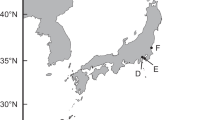Abstract
Fenoxycarb 0-ethyl N-(2-(4-pheoxyphenoxy)-ethyl) carbamate is the most potent juvenile hormone analogue against a variety of insect species including the silkworm Bombyx mori. In this study, the effects of fenoxycarb on silkworm Bombyx mori brain neurosecretory cells in 5th instar were investigated. Fenoxycarb (1 ng/10 µl) was applied topically along the dorsa-medial line to the animals in the spinning behavior on day 1 of the experimental group. Brains removed by dissection were histologically examined by hematoxylin eosin (hem&eosin) and paraldehyde fuchsin staining. Three types of neurosecretory cells (NSCs) were identified, NSC-1, NSC-2 and NSC-3. It was determined that cell secretions were in different density on different days. It was shown that the secretion density of cells on different days was not the same as the experimental and control groups. The fenoxycarb was found to suppress the bombyxin (insulin-like peptides) secretion of cells in the spinning behavior on day 2. Also, it stimulated the division of NSCs on the spinning behavior on day 5.



Similar content being viewed by others
References
Akai H (1988) Hormonal regulation of larval development and its utilization in silk production by [silkworm] Bombyx silkmoth. JARQ (Japan), Tokyo
Akai H, King RC (eds) (1982) Insect ultrastructure, vol 1. Springer
Akai H, Nagashima T, Aoyagi S, Endo Y, Uwo MF, Asaoka K, Kobayashi E (1996) Development and secretory function of neurosecretory A cell in brain of Bombyx mori. Arch Insect Biochem Physiol 32(3–4):333–340
Bassurmanova OK, Panov AA (1967) Structure of the neurosecretory system in Lepidoptera. Light and electron microscopy of type A′- neurosecretory cells in the brain of normal and starved larvae of the silkworm Bombyx mori. Gen Comp Endocrinol 9(2):245–262
Chapman RF, Chapman RF (1998) The insects: structure and function. Cambridge University Press, Cambridge
Demirsoy A (1997) Yaşamın Temel Kuralları, Entomoloji, Ankara Volume 2, Part 2, 5th edn. Meteksan AS, Ankara
Geldiay S, Edwards JS (1973) The protocerebral neurosecretory system and associated cerebral neurohemal area of Acheta domesticus. Zeitschrift für Zellforschung und Mikroskopische Anatomie 145(1):1–22
Gilbert LI (ed) (2011) Insect endocrinology. Academic Press, Cambridge
Goncu E, Parlak O (2011) The influence of juvenile hormone analogue, fenoxycarb on the midgut remodeling in Bombyx mori (L.1758) (Lepidoptera: Bombycidae) during larval-pupal metamorphosis. Turk J Entomol 35:179–194
Hartenstein V (2006) The neuroendocrine system of invertebrates: a developmental and evolutionary perspective. J Endocrinol 190(3):555–570
Ichikawa T (1991) Architecture of cerebral neurosecretory cell systems in the silkworm Bombyx mori. J Exp Biol 161(1):217–237
Klowden MJ (2013) Physiological systems in insects. Academic Press, Cambridge
Mizoguchi A, Ohashi Y, Hosoda K, Ishibashi J, Kataoka H (2001) Developmental profile of the changes in the prothoracicotropic hormone titer in hemolymph of the silkworm Bombyx mori: correlation with ecdysteroid secretion. Insect Biochem Mol Biol 31(4–5):349–358
Niimi S, Sakurai S (1997) Development changes in juvenile hormone and juvenile hormone acid titers in the hemolymph and in vitro juvenile hormone synthesis by corpora allata of the silkworm, Bombyx mori. J Insect Physiol 43(9):875–884
Nijhout HF, Grunert LW (2002) Bombyxin is a growth factor for wing imaginal disks in Lepidoptera. Proc Natl Acad Sci 99(24):15446–15450
Park Y, Rangel C, Reynolds MM et al (2003) Drosophila perlecan modulates FGF and hedgehog signals to activate neural stem cell division. Dev Biol 253(2):247–257
Parlak O, Ünal G (1999) Differentiation of brain neurosecrotory cells depending on ecdysteroid content of haemolymph during 5th. Instar Larval Stage of Silkworm, Bombyx mori. Turk J Zool 23(EK2):733–738
Raabe M (2012) Insect neurohormones. Springer, Berlin
Shimizu I, Aoki S, Ichikawa T (1997) Neuroendocrine control of diapause hormone secretion in the silkworm, Bombyx mori. J Insect Physiol 43(12):1101–1109
Sullivan J (2000) Environmental fate of fenoxycarb. Environmental monitoring fate reviews. Environmental Monitoring Branch, Department of Pesticide Regulation, California EPA, Sacramento, CA, USA. http://www.cdpr.ca.gov/docs/empm/pubs/envfate.htm
Tufan S, Öber A, İzzetoğlu GT (2009) Bombyx mori Linnaeus (Lepidoptera: Bombycidae)’nin Gelişim Evrelerinde Beynin Histolojik Açıdan Araştırılması. Kafkas Univ Vet Fak Derg. 15(6):847–854
Wang GB, Zheng Q, Shen YW, Wu XF (2016) Shotgun proteomic analysis of Bombyx mori brain: emphasis on regulation of behavior and development of the nervous system. Insect Sci 23(1):15–27
Acknowledgments
We thank team of Silkworm and Insect Physiology Laboratories of Department of Biology at Ege University.
Author information
Authors and Affiliations
Corresponding author
Ethics declarations
Conflict of interest
The authors declare that they have no conflict of interest.
Additional information
Publisher's Note
Springer Nature remains neutral with regard to jurisdictional claims in published maps and institutional affiliations.
Rights and permissions
About this article
Cite this article
Tanriverdi O, E., Yelkovan, S. Histological investigation of the effects of fenoxycarb on neurosecretory cells in the silkworm, Bombyx mori brain. Invert Neurosci 20, 20 (2020). https://doi.org/10.1007/s10158-020-00253-3
Received:
Accepted:
Published:
DOI: https://doi.org/10.1007/s10158-020-00253-3




